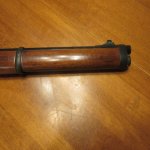It would be interesting to try a #31 and then a #28 drill in the holes and see what their diameter is. The #31 should bottom. #28, the clearance drill for 6-48 shouldn't enter the holes.
From the photos, it appears that threads barely started. I'd be interested in seeing if a 6-48 bottoming tap would engage those partial threads and cut further into the holes.
It almost looks as if the mounting screws were pegs and the base was glued on.
From the look of the adhesive lumps, it appears that the bottom of the base was not a good fit on the barrel. There shouldn't be enough room for gobs.
Drilling and tapping blind holes is one of the jobs that gives one white hair. Measure diameter, and knowing the diameter of the bore, calculate wall thickness. Then calculate the depth that can be safely drilled. Plug then bottoming taps, to get as many good threads as possible. I hate mounting front sight ramps on sporter barrels.
Agree with all of that. - dan








































































